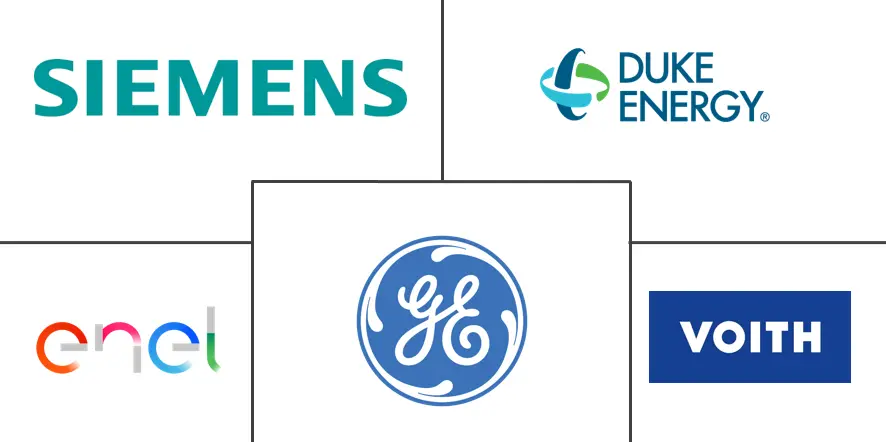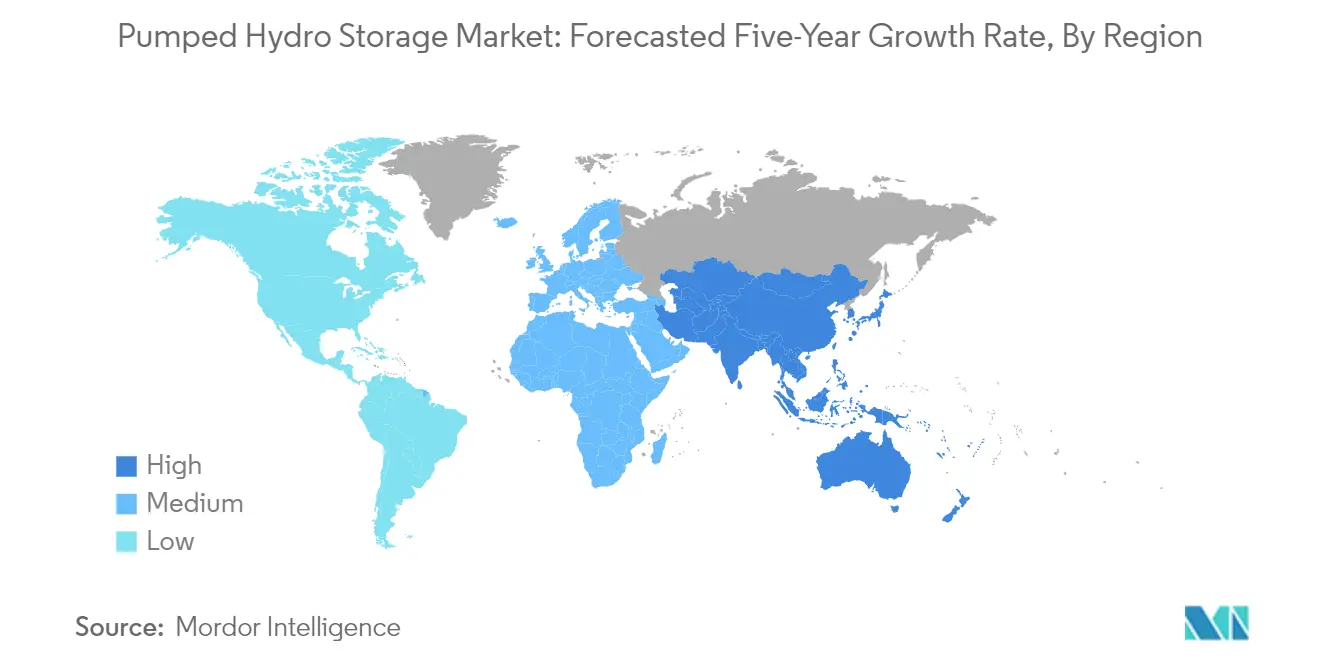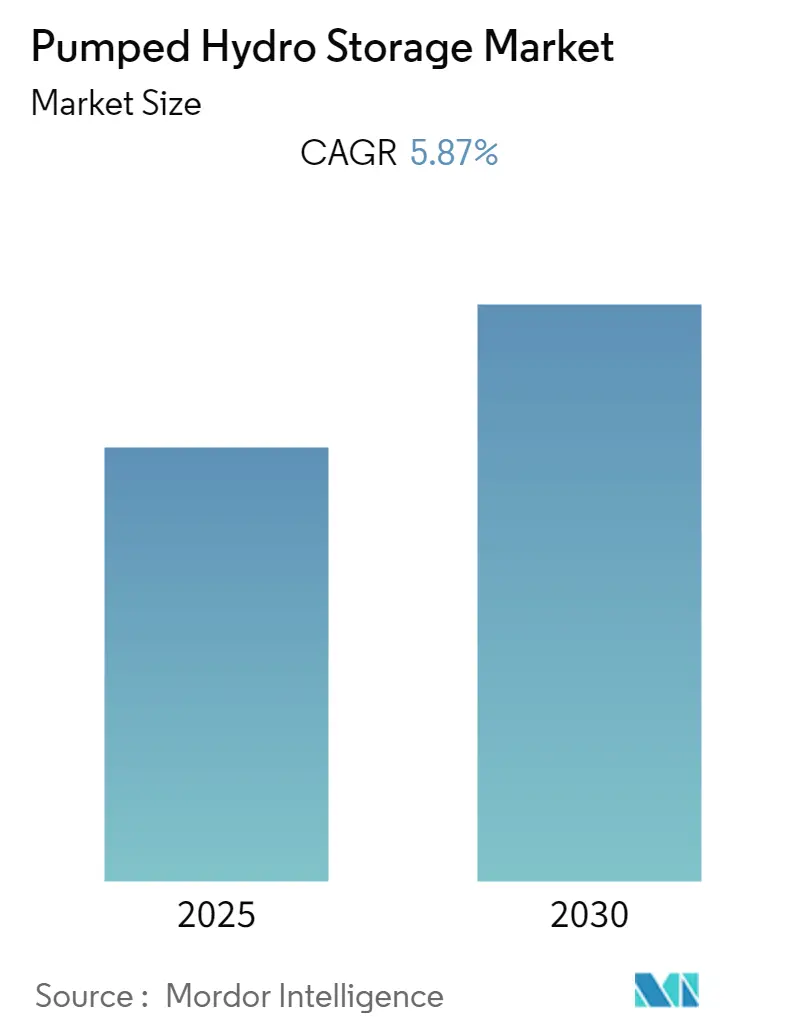
Pumped Hydro Storage Market Analysis
The Pumped Hydro Storage Market is expected to register a CAGR of 5.87% during the forecast period.
The pumped hydro storage (PHS) industry continues to demonstrate its crucial role in global energy infrastructure, with the International Hydropower Association projecting nearly 240 GW of new PHS projects to come online by 2030. This technology maintains its position as the most mature and reliable large-scale energy storage solution, achieving a technical readiness level (TRL) of 9, the highest possible rating for commercial deployment. The industry's stability is further reinforced by the technology's impressive round-trip efficiency of 80%, making it one of the most efficient large-scale energy storage solutions available. These fundamental advantages continue to drive substantial investments and development initiatives across major markets.
The industry is witnessing significant technological advancements and innovative project developments. A notable example is the September 2021 World Bank approval of a USD 380 million loan for Indonesia's first pumped-storage hydropower plant, marking a significant milestone in Southeast Asian energy infrastructure development. The technology's remarkable 40-year calendar lifetime, substantially longer than competing storage solutions, continues to attract major infrastructure investors and utility operators seeking long-term, reliable clean energy storage solutions. This longevity factor has become increasingly important as nations develop their long-term renewable energy integration strategies.
The market is experiencing a shift toward more sophisticated and larger-scale projects, exemplified by China's 3.6 GW Fengning pumped-storage power station, which is set to become the world's largest facility of its kind. The industry is also seeing innovation in project financing and development models, with new public-private partnerships emerging to support large-scale installations. These developments are complemented by increasing integration of digital technologies and advanced control systems, enabling more efficient operation and grid energy storage capabilities.
The sector is witnessing growing interest in novel PHS technologies, particularly in seawater-based systems and underground storage solutions utilizing existing mines. These innovations are expanding the potential application scope while addressing environmental concerns and cost considerations. The industry is also seeing increased attention to small-scale decentralized PHS systems, which can be integrated into existing infrastructure such as drinking water networks and artificial snow-making facilities, demonstrating the technology's adaptability to diverse applications and scales of operation.
Pumped Hydro Storage Market Trends
Growing Integration of Renewable Energy and Grid Stability Requirements
The increasing integration of variable renewable energy storage sources into power grids has created a critical need for large-scale energy storage solutions, positioning pumped hydro storage as an essential technology for grid stabilization. Pumped hydro storage systems demonstrate superior technical capabilities with a round-trip efficiency of 80% and an impressive 13,870 storage cycles, making them highly effective for managing intermittent renewable energy generation. The technology's ability to provide black start capability and reactive power control further enhances its value proposition for grid operators seeking reliable storage solutions.
The long operational lifespan of pumped hydro storage facilities, reaching up to 40 years, significantly outperforms alternative storage technologies such as lithium-ion batteries (10 years) and lead-acid batteries (12 years). This extended lifetime, combined with the highest technical readiness level (TRL) of 9, makes pumped hydro storage a proven and dependable solution for utilities and power producers looking to enhance grid flexibility while supporting renewable energy integration.
Supportive Government Policies and Carbon Neutrality Targets
Government initiatives and ambitious carbon neutrality targets across various regions are driving significant investments in pumped hydro storage infrastructure. For instance, China's comprehensive mid- and long-term plans for pumped storage hydropower development, targeting 120 GW capacity by 2030, demonstrate strong governmental support for this technology. These policy frameworks are complemented by international financial institutions' backing, as evidenced by the World Bank's recent initiatives to promote sustainable hydropower investments in South Asian nations.
The implementation of new projects reflects this supportive policy environment, with South Korea announcing the construction of three new facilities totaling 1.8 GW in Pocheon, Hongcheon, and Yeongdong, scheduled for completion by 2034. Similarly, Indonesia's commitment to pumped hydro storage is demonstrated through the Sumatera Pump Storage project, a 500 MW facility planned for construction in 2024 with an estimated investment of USD 1.107 billion. These developments highlight how government support and clear policy directions are accelerating the adoption of pumped hydro storage technology across major economies, contributing to the growth of the energy storage market.
Environmental Benefits and Regulatory Advantages of Closed-Loop Systems
The environmental advantages of closed-loop pumped hydro storage systems have emerged as a significant driver for market growth, particularly due to their minimal impact on existing river systems and natural water flows. These systems offer greater flexibility in site selection as they can be positioned where grid support is needed rather than being constrained to locations near natural water sources. The reduced environmental footprint has resulted in increased certainty in obtaining operating licenses and permits, as evidenced by the rising number of licensing applications and preliminary permits for closed-loop systems reported by the Pacific Northwest National Laboratory.
Closed-loop systems demonstrate superior operational characteristics, including high flexibility, reliability, and power output capabilities, while minimizing environmental concerns related to aquatic ecosystems. This environmental compatibility has led to accelerated approval processes and broader stakeholder acceptance, making closed-loop systems particularly attractive for new project developments. The ability to create artificial reservoirs without impacting natural water bodies has opened up new possibilities for project locations, enabling developers to optimize site selection based on grid requirements rather than geographical constraints. This aligns with the growing demand for long-duration energy storage solutions in the energy storage market.
Segment Analysis: Type
Closed-Loop Segment in Pumped Hydro Storage Market
The pumped hydro storage market is dominated by the closed-loop segment, commanding approximately 67% market share in 2024. This segment's leadership position is driven by several key advantages, including minimal environmental impact since these systems are not connected to existing river systems. Closed-loop pumped hydro storage offers high flexibility, reliability, and high-power output capabilities while maintaining a lower environmental footprint compared to open-loop systems. The segment's growth is further supported by greater certainty in gaining operating licenses and permits, as these systems do not interfere with existing river systems or water streams. According to studies by the Australian National University, there are over 616,000 potential sites globally for closed-loop pumped hydro storage projects, representing a combined storage potential of 23,000 TWh. This massive untapped potential, coupled with an increasing focus on grid stability and renewable energy storage integration, continues to drive the segment's market dominance.
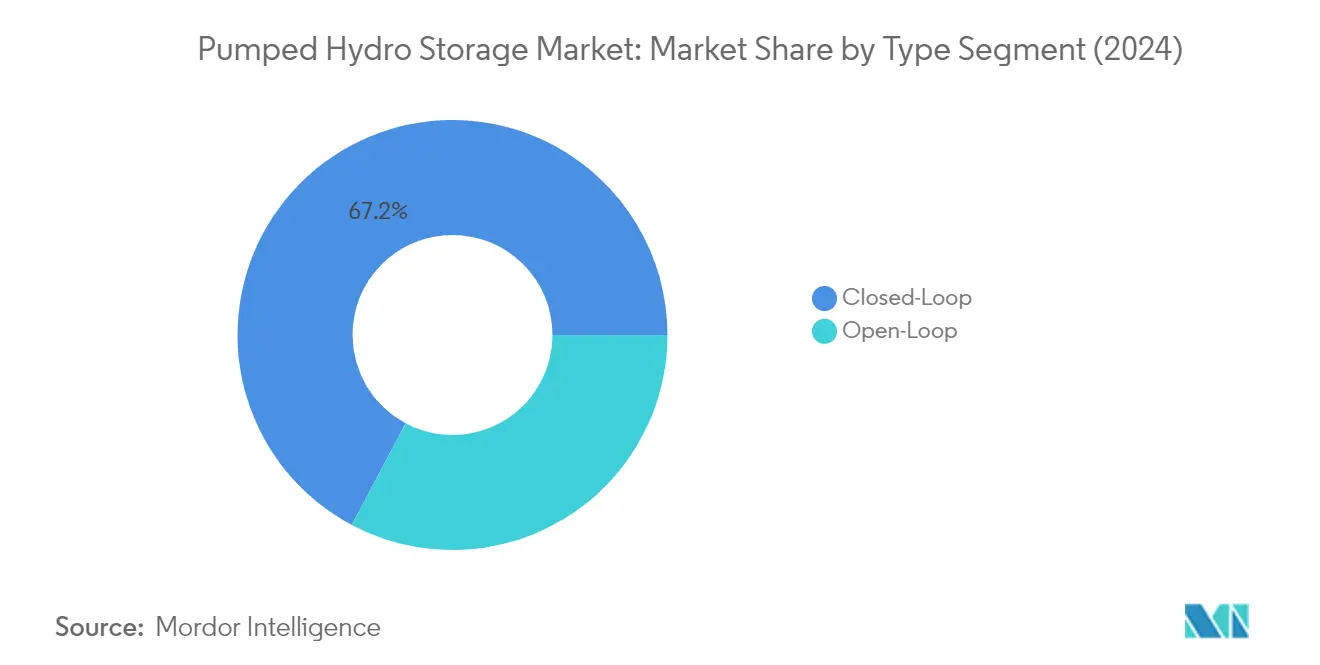
Open-Loop Segment in Pumped Hydro Storage Market
The open-loop segment maintains a significant presence in the pumped hydro storage market, benefiting from its direct connection with natural water resources such as rivers and streams. These systems are particularly advantageous in regions with abundant water streams and where the cost of developing alternative systems would be prohibitive. The relatively low cost associated with the construction and replenishing of the upper reservoir continues to make open-loop systems an attractive option in certain geographical locations. However, environmental concerns regarding the impact on aquatic ecosystems and fish passages have led to increased scrutiny of new open-loop projects. Despite these challenges, the segment maintains its relevance in the market, especially in regions with established hydroelectric infrastructure and favorable geographical conditions that can support such systems. As part of the broader mechanical energy storage solutions, open-loop systems contribute significantly to grid energy storage and load balancing storage, ensuring a stable and reliable power storage solution.
Pumped Hydro Storage Market Geography Segment Analysis
Pumped Hydro Storage Market in North America
North America represents approximately 15% of the global pumped hydro storage market capacity in 2024, establishing itself as a significant player in the hydropower market. The region's market is characterized by a robust infrastructure of existing facilities, particularly concentrated in the United States. The market dynamics are primarily driven by the increasing integration of renewable energy storage solutions into the power grid, necessitating reliable grid energy storage solutions. The region's regulatory framework strongly emphasizes grid reliability and stability, which continues to support the development of pumped hydro storage projects. Technological advancements in variable speed pumps and advanced control systems have enhanced the operational efficiency of existing facilities. The market is witnessing a shift towards closed-loop systems, which offer reduced environmental impact and greater flexibility in site selection. Utility companies are increasingly recognizing pumped hydro storage as a crucial component in their long-term power storage strategies, particularly for grid balancing and peak load management applications.
Pumped Hydro Storage Market in Europe
Europe has demonstrated a steady growth trajectory in the pumped hydro storage market, recording approximately 6% growth from 2019 to 2024. The region's market is characterized by a mature infrastructure with significant installations across multiple countries, particularly in Italy, Germany, and Austria. The European market's evolution is closely tied to the region's aggressive renewable energy targets and commitment to carbon neutrality. The integration of pumped hydro storage systems plays a crucial role in managing the intermittency of renewable energy sources, particularly wind and solar power. Market development is supported by strong policy frameworks and environmental regulations that favor clean energy storage solutions. The region's focus on grid modernization and energy security has led to increased investments in upgrading existing facilities and developing new projects. European utilities are particularly interested in advanced pumped storage technologies that offer enhanced flexibility and efficiency in operation.
Pumped Hydro Storage Market in Asia-Pacific
The Asia-Pacific pumped hydro storage market is projected to experience robust growth of approximately 50% from 2024 to 2029, emerging as the most dynamic region in the global hydropower market. The market is characterized by extensive development activities, particularly in China and Japan, which serve as the regional powerhouses for pumped storage technology. The region's rapid industrialization and urbanization continue to drive the demand for reliable grid storage solutions. Market growth is supported by strong government initiatives promoting renewable energy integration and grid stability. The development of large-scale projects is complemented by technological innovations in pump-turbine design and control systems. The region's diverse geography provides numerous suitable locations for both traditional and innovative pumped storage projects. Investment in grid infrastructure and mechanical energy storage capabilities continues to expand, driven by the need to support the region's growing renewable energy capacity.
Pumped Hydro Storage Market in South America
The South American pumped hydro storage market represents a developing segment with significant untapped potential. The region's extensive hydroelectric infrastructure provides a strong foundation for pumped storage development. Market growth is primarily driven by the increasing need to integrate variable renewable energy sources into the grid system. The region's diverse topography offers numerous suitable locations for pumped storage projects, particularly in countries with mountainous terrain. Utility companies are showing growing interest in pumped storage as a solution for grid stability and peak load management. The market is characterized by a mix of both open-loop and closed-loop systems, with increasing preference for environmentally sustainable solutions. Regional cooperation in energy infrastructure development is creating new opportunities for cross-border pumped storage projects.
Pumped Hydro Storage Market in Middle East & Africa
The Middle East and Africa region represents an emerging market for pumped hydro storage, with significant growth potential in both regions. The market is characterized by increasing investments in renewable energy infrastructure and grid stability solutions. Development activities are particularly notable in countries focusing on diversifying their energy portfolios away from traditional fossil fuels. The region's challenging climate conditions have led to innovative approaches in pumped storage design and operation. Market growth is supported by increasing government initiatives to enhance grid reliability and support renewable energy integration. The development of closed-loop systems is gaining traction, particularly in areas with limited water resources. The market shows promising potential for hybrid systems combining pumped storage with other renewable energy technologies.
Pumped Hydro Storage Industry Overview
Top Companies in Pumped Hydro Storage Market
The pumped hydro storage companies market features prominent players like Duke Energy, E.ON, Enel, EDF, Iberdrola, GE, Siemens, Andritz, Mitsubishi Heavy Industries, and Voith, who are leading technological advancement and market expansion. Companies are increasingly focusing on developing innovative solutions, such as seawater-based PSH systems and underground storage technologies, to enhance operational efficiency and reduce environmental impact. Strategic collaborations and joint ventures are becoming more common, particularly for large-scale project development and technology sharing. Market leaders are expanding their geographical presence through targeted acquisitions and partnerships, especially in regions with high renewable energy potential. The industry is witnessing a trend toward digital integration and smart technologies, with companies investing in automation and control systems to optimize plant operations and maintenance.
Consolidated Market with Strong Regional Players
The pumped hydro storage market exhibits a moderately consolidated structure dominated by large multinational conglomerates with diverse energy portfolios, alongside specialized regional players focusing on specific geographical markets. These established players leverage their extensive experience, technical expertise, and financial resources to maintain market positions through continuous innovation and service expansion. The market is characterized by high entry barriers due to substantial capital requirements, complex regulatory frameworks, and the need for specialized technical expertise, which limits new entrant participation.
The industry has witnessed significant merger and acquisition activity, particularly focused on technology acquisition and market expansion into emerging economies. Major players are increasingly pursuing strategic partnerships with local entities to strengthen their regional presence and overcome regulatory hurdles. The market structure is further influenced by government policies and renewable energy initiatives, which often determine project viability and investment patterns. Companies are also forming consortiums to share project risks and leverage complementary capabilities, especially for large-scale installations.
Innovation and Sustainability Drive Future Growth
Success in the energy storage industry increasingly depends on companies' ability to develop cost-effective, environmentally sustainable solutions while maintaining operational efficiency. Market leaders are focusing on developing advanced technologies that reduce construction costs and environmental impact, while improving system flexibility and response times. Companies are also investing in research and development to create innovative solutions for specific geographical and technical challenges, such as seawater-based systems and underground storage facilities. The ability to integrate digital technologies and provide comprehensive maintenance services is becoming crucial for maintaining competitive advantage.
Future market success will require companies to navigate complex regulatory environments while meeting growing demands for renewable energy integration. Players must develop strategies to address environmental concerns and community engagement, particularly for new project developments. The market presents opportunities for companies that can offer modular and scalable solutions, especially in regions with limited suitable sites for traditional pumped storage facilities. Success will also depend on the ability to form strategic partnerships with renewable energy developers and grid operators, as the role of energy storage in grid stability becomes increasingly important. Companies must also focus on developing a skilled workforce and maintaining strong relationships with key stakeholders to ensure long-term success.
Pumped Hydro Storage Market Leaders
-
Siemens AG
-
Enel SpA
-
Duke Energy Co.
-
Voith GmbH & Co. KGaA
-
General Electric Company
- *Disclaimer: Major Players sorted in no particular order
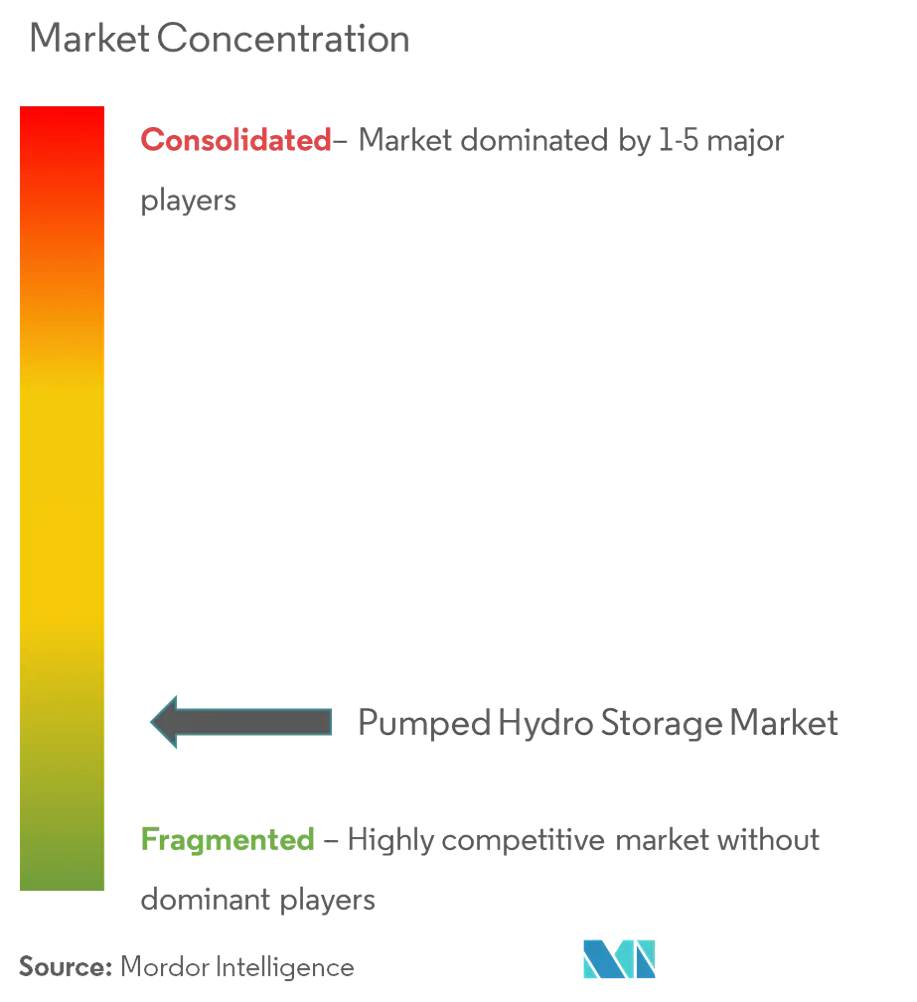
Pumped Hydro Storage Market News
- January 2023: The Greenko Group announced an investment of USD 1.2 billion to set up a pumped storage project in the Neemuch district of Madhya Pradesh, India. The project will have a daily storage capacity of 11 GWh. Further, the pumped hydro storage project will be connected to the interstate transmission system network and is expected to be commissioned in December 2024.
- June 2022: The State Investment Promotion Board (SIPB) of Andhra Pradesh, India, approved Adani Green Energy's 4 hydro-pumped storage projects with a total capacity of 3,700 MW. The project requires an investment of USD 2 billion. The company is likely to build a 1,200-MW project in Kurukutti and a 1,000-MW plant in Karrivalasa. In addition, a 1,000 MW project will be set up in Gandikota, and a 500 MW plant in Chitravathi.
Pumped Hydro Storage Market Report - Table of Contents
1. INTRODUCTION
- 1.1 Scope of the Study
- 1.2 Market Definition
- 1.3 Study Assumptions
2. RESEARCH METHODOLOGY
3. EXECUTIVE SUMMARY
4. MARKET OVERVIEW
- 4.1 Introduction
- 4.2 Pumped Hydro Installed Capacity and Forecast in GW, till 2028
- 4.3 Hydro Power Installed Capacity and Forecast in GW, till 2028
- 4.4 Hydroelectricity Generation in TWh, 2013-2021
- 4.5 Recent Trends and Developments
- 4.6 Government Policies and Regulations
-
4.7 Market Dynamics
- 4.7.1 Drivers
- 4.7.2 Restraints
- 4.8 Supply Chain Analysis
-
4.9 Porter's Five Forces Analysis
- 4.9.1 Bargaining Power of Suppliers
- 4.9.2 Bargaining Power of Consumers
- 4.9.3 Threat of New Entrants
- 4.9.4 Threat of Substitutes Products and Services
- 4.9.5 Intensity of Competitive Rivalry
- 4.10 Cost of Pumped Hydro Energy Storage System
5. MARKET SEGMENTATION
-
5.1 Type
- 5.1.1 Open-loop
- 5.1.2 Closed-loop
-
5.2 Geography
- 5.2.1 North America
- 5.2.2 Europe
- 5.2.3 Asia-Pacific
- 5.2.4 South America
- 5.2.5 Middle-East and Africa
6. COMPETITIVE LANDSCAPE
- 6.1 Mergers and Acquisitions, Joint Ventures, Collaborations, and Agreements
- 6.2 Strategies Adopted by Leading Players
-
6.3 Company Profiles
- 6.3.1 Operators
- 6.3.1.1 Duke Energy Corporation
- 6.3.1.2 EON SE
- 6.3.1.3 Enel SpA
- 6.3.1.4 Electricite de France SA (EDF)
- 6.3.1.5 Iberdrola SA
- 6.3.2 Technology Providers
- 6.3.2.1 General Electric Company
- 6.3.2.2 Siemens AG
- 6.3.2.3 Andritz AG
- 6.3.2.4 Mitsubishi Heavy Industries Ltd
- 6.3.2.5 Voith GmbH & Co. KGaA
- 6.3.2.6 Ansaldo Energia SpA
- *List Not Exhaustive
7. MARKET OPPORTUNITIES AND FUTURE TRENDS
Pumped Hydro Storage Industry Segmentation
Pumped storage hydropower (PSH) is a type of hydroelectric energy storage. It is a configuration of two water reservoirs at different elevations that can generate power as water moves from one to the other (discharge), passing through a turbine. The system also requires power to pump water back into the upper reservoir (recharge). The pumped hydro storage market is segmented by type and geography. By type, the market is segmented into open-loop and closed-loop. The report also covers the market size and forecasts for the pumped hydro storage market across the major regions. For each segment, market sizing and forecasts have been done based on installed capacity (gigawatts).
| Type | Open-loop |
| Closed-loop | |
| Geography | North America |
| Europe | |
| Asia-Pacific | |
| South America | |
| Middle-East and Africa |
Pumped Hydro Storage Market Research FAQs
What is the current Pumped Hydro Storage Market size?
The Pumped Hydro Storage Market is projected to register a CAGR of 5.87% during the forecast period (2025-2030)
Who are the key players in Pumped Hydro Storage Market?
Siemens AG, Enel SpA, Duke Energy Co., Voith GmbH & Co. KGaA and General Electric Company are the major companies operating in the Pumped Hydro Storage Market.
Which is the fastest growing region in Pumped Hydro Storage Market?
Middle-East and Africa is estimated to grow at the highest CAGR over the forecast period (2025-2030).
Which region has the biggest share in Pumped Hydro Storage Market?
In 2025, the Asia-Pacific accounts for the largest market share in Pumped Hydro Storage Market.
What years does this Pumped Hydro Storage Market cover?
The report covers the Pumped Hydro Storage Market historical market size for years: 2019, 2020, 2021, 2022, 2023 and 2024. The report also forecasts the Pumped Hydro Storage Market size for years: 2025, 2026, 2027, 2028, 2029 and 2030.
Our Best Selling Reports
Pumped Hydro Storage Market Research
Mordor Intelligence provides a comprehensive analysis of the pumped hydro storage market. We leverage our extensive expertise in the energy storage industry to deliver valuable insights. Our latest report explores the growing importance of PHS (Pumped Hydro Storage) technology in renewable energy storage applications. It includes detailed insights into developments within the hydroelectric power industry.
The analysis covers crucial aspects of mechanical energy storage systems, grid energy storage solutions, and electrical energy storage technologies. This information is invaluable for stakeholders interested in grid stabilization and load balancing storage capabilities.
Our detailed report is available as an easy-to-download PDF. It offers strategic insights into long duration energy storage market trends and utility scale energy storage developments. Stakeholders can access comprehensive data on pumped storage hydropower companies and their contributions to grid flexibility and clean energy storage solutions.
The analysis also covers bulk energy storage applications, hydropower market dynamics, and emerging opportunities in large scale energy storage. This enables informed decision-making for industry participants aiming to optimize their market positioning in the evolving power storage industry.

